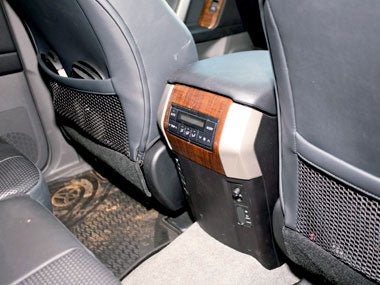Tow test: Toyota Prado Kakadu 150 Series

TOYOTA'S LANDCRUISER PRADO (to use its full moniker) has been around for many years and the latest model, the fourth generation 150 Series, shows a considerable amount of experience in its design. Available in five and three-door styles, there are a total of 14 models available, so there is something for just about every budget. All are longer, wider and slightly lower than previous models.
I suspect the external body features will take a bit of getting used to for some, and from a practical point of view I can’t imagine the three-door model would much appeal, even with only two people in the vehicle.
ATTRIBUTES
The Kakadu is the most feature-laden model in the Prado range (it may be easier to list what it doesn’t have). To name just a few features: seven airbags; xenon headlights; auto wipers; three-zone climate control with separate front and rear controls; cooler box between the front seats; steering-mounted audio controls; a 4.3in screen for satellite navigation and audio; DVD player for rear seats; front and rear camera; and a 100W inverter. An iPod or similar MP3 player can be connected into the audio system via a USB plug or 3.5mm socket.
The driver’s instrument panel (generally easily seen) comes with two main vacuum fluorescent Optitron meters – very stylish – plus a trip information panel that includes cruising range, average fuel consumption, average speed and total run time.
Both of the leather-upholstered front seats come with automatic position memories and electric heaters. I would normally not get much use out of the heaters, but they were very appreciated on one unexpectedly cold day.
ENGINE AND TRANSMISSION
Producing maximum power of 127kW and torque of 410Nm, the 3L turbodiesel responds well to the right foot. That power is delivered through a five-speed automatic transmission and full time 4WD with a lockable Torsen centre differential and two-speed transfer.
While many caravanners won’t have much use for the 4WD function, the auto transmission moves very smoothly through the gears when towing, and the four-wheel disc brakes stop things equally well.
The keyless ignition is one feature that might be a little daunting for some older RVers. While I did become used to it fairly quickly, this system is somewhat disconcerting to those of us who have always used keys and have only seen dashboard and floor-button starters in museum cars. That said, it started smoothly every time.
SUSPENSION
Up front, this Prado comes with independent double wishbones (with coil springs) adaptive variable rate shock absorbers with four ride comfort levels and a ball joint-mounted anti-roll bar.
The back of the vehicle is a slightly different story, featuring rigid live axle, five-link trailing arms and Panhard rod, adaptive rear pneumatic cylinders with three selectable suspension heights, four ride comfort levels, self-levelling and a ball joint-mounted anti-roll bar.
In addition, the Kakadu comes with Toyota’s Kinetic Dynamic Suspension System (KDSS), which means the vehicle has a good set of on-road manners at all times.
Like many of its class, the Kakadu’s ride is occasionally a little harsh, but it is mostly a comfortable experience. I do like the adjustable rear suspension, which operates automatically whenever the van is hitched or unhitched – the only clue to its operation is a slight “brrrr” from the air compressor.
ECONOMY
Since I spent some considerable time behind the wheel – my journey took me from Sydney to Broken Hill via Melbourne, and back to Melbourne – I was able to get a variable set of figures for different driving styles.
Running light (no caravan) between the capital cities returned an average diesel consumption of 10.51L/100km. With the Concept Icon and its 1595kg Tare on the back, consumption increased to 13.8L/100km. That was travelling in a convoy at around 80-90km/h.
The driving around Broken Hill was mostly country, but it included a great deal of stopping and starting for photography, and returned consumption numbers of 16.3L/100km. The return trip to Melbourne, however, was done at maximum speed and saw the Kakadu get 17.8L/100km.
TOWING
The 3L turbodiesel engine made light work of the Concept van, and the vehicle’s maximum towing capacity of 2500kg gives plenty of confidence for a larger van.
One of the (many) side effects of setting up photo shoots is the stopping, starting, reversing, U-turning and general manoeuvring, but the Kakadu handled everything with ease.
There was a slight problem with the viewing angle of the rear view camera, which is neatly fitted into the spare wheel cover. It does give a good view, but sitting in the centre of the rig means it takes some practice to use it effectively when hitching up.
The towing package includes an electric brake controller, with the controls not far from the driver’s right hand.
Our extension mirrors had to be removed on occasion as they frequently caused the external mirrors to fold in.
THE BOTTOM LINE
Toyota’s Prado Kakadu is a very solid tow vehicle. It’s well appointed throughout, although I did wonder about a few practicalities when we encountered some very muddy conditions. Once clear of the mud and dirt, cleaning up took longer than I expected, especially on the floors, and the grills of the door speakers were a bit of a challenge after they were easily soiled by muddy boots.
The Kakadu’s $96,596 drive-away price tag may scare some people off. However, if you are happy to live with fewer goodies, a base level Prado can be yours for about $30,000 less. I’m confident it would give many years of relaxing and reliable towing.
TOYOTA PRADO KAKADU 15 SERIES
Engine: 3L four-cylinder turbodiesel common rail
Max Power: 127kW@3400rpm
Max Torque: 410Nm@1600rpm
Transmission: Five-speed auto
Length: 4930mm
Width: 1885mm
Height: 1880mm
Wheelbase: 2790mm
Ground clearance: 220mm
Kerb Mass: 2420kg
Gross Vehicle Mass: 2990kg
Gross Combined Mass: 5475kg
Fuel tank capacity: 150L
Towing capacity unbraked/braked: 750/2500kg
TBM maximum: 250kg
Price as shown: $96,596 (drive-away, Vic).







